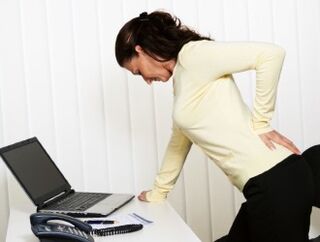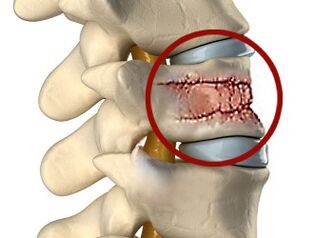
Almost everyone is familiar with back pain., and 15-20% must deal with this symptom regularly throughout the year.
The problem is not only a medical one, but also a socioeconomic one in nature, as during illness, patients lose their ability to work depending on the cause of the problem.
In most cases, the disease is freed within a month, after which the patient can return to a normal life.
Despite these results, pain recurred in 70% of patients but was ineffective due to incorrect or inadequate treatment.
Pain to be aware ofis a hallmark of the spinal degenerative process, which in turn is considered a hallmark of a pathological condition.
Classification and nature of back pain
Types of Back Pain:
- nonspecific(benign) - back disease, "outdated" osteochondrosis, the cause is usually a dysfunction of the musculoskeletal system, additional tests are usually useless;
- specific(dangerous) pain requires additional diagnosis at the first visit, which makes it possible to exclude the presence of spinal fractures, tuberculosis, tumors, metastases, etc. ;
- root pain(Radiopathy) - Associated with irritation/compression of the nerve root by a herniated (shed) disc.
What musculoskeletal disorders can cause spinal pain in the center of the back?
Disorders of the musculoskeletal system that cause pain:
- Osteoarthritis- The patient may bend over due to pain, try to straighten the back, take a deep breath leading to an increase in negative sensations, when the vertebrae are squeezed, the load on the elastic shock-absorbing pad increases, so the damaged element becomes thinner;
- Osteochondrosis, thoracic osteochondrosis- develops on the background of obesity, lack of exercise, nutritional imbalances, disorders of mineral metabolism, during age-related changes, the elasticity and height of the intervertebral discs decrease, their structure changes, the compression of nerve fibers leads to sudden, severe pain or moderate discomfort exacerbated by exercise;
- Scoliosis, increased/decreased lordosis, kyphosis- lead to deterioration of posture and appearance, resulting in compression of spinal nerves;
- strut injury;
- Nervous System Causes(radiculitis);
- congenital disease- Extra/missing vertebrae in the spine causing pain and discomfort;
- myositis- In the context of skeletal muscle inflammation, pain diminishes and increases, and discomfort increases on palpation of the back.

Other causes of back pain
other reasons:
- kidney inflammation- Discomfort is often accompanied by high fever, swelling of lower extremities, high blood pressure;
- Cardiovascular disease, vascular lesions - with throbbing back pain and increased blood pressure;
- chronic stress;
- Digestive system diseases- pain in the middle or left side of the back, worsening after eating, pancreatitis or disease of the gastric mucosa;
- Psycho-emotional disorder.
Severe disease of the organs located in the abdominal cavity and below the chest can also cause spinal pain. It is often difficult for patients to determine the nature of the pain, and it is advisable to monitor symptoms and inform the doctor promptly.
Treat Spinal Pain
Before starting treatment, doctors must make a diagnosis, study the patient's medical history, listen to complaints, perform visual inspection and palpation, and study the results of laboratory and diagnostic studies. After that, the necessary medication is selected, the action of which is aimed at correcting the problem.
Preparation
During exacerbations, treatment aims to stop pain signals.
drug:
- NSAIDs- Their role is to stop the mediators of the inflammatory process before they enter the tissues surrounding the spine. It helps to eliminate inflammation, fever, swelling, cramps, pain. In cases of severe pain, injectable preparations are prescribed, they are characterized by a rapid effect (15-20 minutes), safe for the gastrointestinal tract, all components are administered in an initial dose. To get rid of moderate and mild pain, topical preparations or oral medications are prescribed.
- pain reliever- When the analgesic properties of NSAIDs are insufficient, the drug affects the transmission of nerve impulses to the brain, preventing the reaction from occurring. 2 Combination is recommended to be used with caution. Physical characteristics and drug compatibility should be considered. The dose selection varies from person to person.
- muscle relaxant- Disorders of the spine are often accompanied by muscle spasms that force the patient to be rigid in one position, with all movements causing severe pain. An injection of a muscle relaxant will help relax the muscle corset, and its effect lasts for 12 hours. Tablets are used less frequently because they only begin to work after the required amount of the substance has accumulated.
- chondroprotective agent- Problems of the spine appear against the background of the process of degeneration of joint and cartilage tissue, in this case, drugs containing chondroitin or glucosamine are prescribed. Substances are the basis for the recovery of tendons, joints, ligaments, etc. These components are not produced in the body, therefore, during illness, the cells should be saturated as much as possible with the listed substances, usually by oral prescription, and the drug should be taken long-term.
as adjuvant therapyVitamin complexes, diuretics, antispasmodics may be prescribed, and funding aimed at improving nutrition and restoring circulation, antioxidants, antihistamines, and more.
Operation
In the absence of pharmacological effects, surgical treatment is indicated, and modern techniques can achieve great results.For osteochondrosis, injuries and hernias, part of the vertebra or disc is removed, For aortic aneurysms, plastic surgery is required.
In spinal disorders, the source of pain should be identified; many times, the source of unpleasant symptoms is visceral. Only a doctor can diagnose a disease and prescribe treatment.
Exercise, exercise therapy, massage
Moderate physical activity is required if the patient's condition and the nature of the underlying disease course permit.
Doctors also recommend regular morning exercises, and the complex includes the following exercises:
- child pose. Sit on your knees, with your head on the floor and your arms stretched forward, hold this position for 20 seconds, arms also stretched back for 20 seconds, repeat the exercise twice.
- Bend your head.Sit on the floor with your back straight, hands behind your head, and slowly pull your head forward, leaning until your chin touches your neck, hold for 10-15 seconds, repeat 8-10 times.
- twist with a stick. In a standing position, place the gymnastic bar horizontally on the neck behind the head, extend the arms and hold the end of the bar. With a stick behind your head, slowly turn to the left, hold for 25-30 seconds, and repeat in the opposite direction for 10-12 repetitions.
- leaning forwardWith your legs shoulder-width apart and your arms behind the locks, stand up, lean forward with your legs slightly bent at your knees, hold this position for 15-20 seconds, repeat 4-5 times.
- Lean forward, toes touching. Sit on the floor with your legs together in front of you, bend forward and reach your toes with your hands. The exercise should be performed without sudden movements, holding gradually and slowly for a few seconds.
Exercise therapy and other types of physical activity are strictly prohibited during exacerbations.
massage
Manual massage has also been shown to be effective against back pain caused by spinal disorders.. The technique allows you to achieve muscle relaxation, and during the application, the soft tissue is heated, which helps improve blood circulation. This massage is recommended for patients with respiratory diseases accompanied by phlegm discharge.
Home Healing or Folk Remedies
In the presence of persistent back pain, it is recommended to turn to folk remedies and consult a doctor before use. Although seemingly safe, many methods are not only useless, but also harmful.
Recommended for pain reliefready to rubTo do this, you will take a mixture of pure alcohol or cologne, a small amount of cayenne pepper, a tincture of valerian, a bottle of 5% iodine solution, wipe the affected area thoroughly with the mixture, wrap it up. The procedure is recommended in the evening, keeping warm until morning. It is very important not to start the disease, to identify the pathological cause in time and to follow all the advice of the doctor.
The following steps can help ease a family situation:
- Avoid prolonged bed rest - physically active patients have less pain;
- engage in light exercise - moderate physical activity is best;
- maintain correct posture;
- increase the flexibility of the spine;
- wear a corset and belt for the spine;
- Apply heat and cold to the affected area;
- Smoking cessation - nicotine can cause spasms in small blood vessels, which can disrupt microcirculation and stop oxygen delivery to tissues;
- Relaxation practice.
prevention
The patient can prevent the development of the back disease on his own, he must learn to sleep, sit and stand correctly, and bear heavy loads with minimal damage to himself. It is recommended to stand and sit with your back straight, your head not drooping forward, and your body not leaning on your hands.
If you need to stand for long periods of time, find a point to support your head and limbs, which can be leaned against a surface such as a closet, wall, etc. Excluding walking in high heels for more than 2 hours continuously, the legs should be rested regularly by raising them for a few minutes.
Precaution:
- Remove the neck and lower back with a special roller or "bone" pillow and avoid sitting on a stool or flexing the back every 15 minutes. You should change positions, stretch and lean back, and take breaks every hour of sitting;
- You need to sleep on a firm mattress without high pillows, you can put orthopedic rollers under your head;
- Certain rules must be followed when carrying, women are not allowed to carry items over 3 kg, men are not allowed to carry items over 5 kg, it is dangerous to lift weights when bending over or yanking, carry bags with your back straight, and heavy loads should be divided into severalsteps to proceed.
in conclusion
- back pain- A relatively common pathology where pain syndrome occurs and you should seek medical help.
- Pathological causes are very different, the doctor makes the diagnosis based on the patient's medical history, examination, and complaints.
- During treatmentusing drugs(mainly pain relievers), massage, exercise therapy is recommended.



















